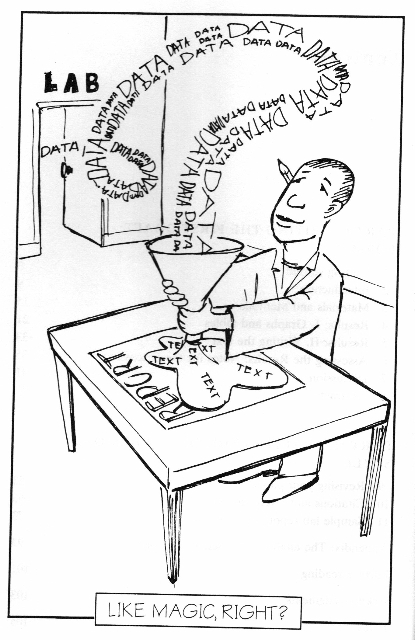AP 4018y
On preparing your first lab report
As you're preparing your first lab report, I want to pass along some comments and suggestions.
First, some reminders: You and your lab partner can work together to analyze and plot your data. When analyzing your data be sure your understand precisely how your numbers related to the physical quantities that you are trying to measure. Understand your units and any calibration or correction factors. When summarizing your data, decide whether or not it is best to use a table or a graph. In both cases, make sure that data are properaly labeled.
Second, the secret to writing good reports is to make your language clear, concise, and easy to read.
Finally, here's some hints from "Successful Lab Reports: A Manual for Science Students" by Lobban and Schefter (Cambridge, 1992) and from myself. Like magic right? Not really....

Before you begin writing your lab report:
- Make sure that you understand all steps involved with your data analyses by making one or more calculations and deriving any values needed to interpret your results. If you have any question or encounter problems, be sure that you show these to me so that I can help.
- Complete your data analyses, make any graphs, and examine your results. Note: presenting these results, together with the method by which they were obtained, is main task of your lab report! Take a moment, and ask what is the best way to present your results and explain your method?
- Write your first draft. It should have the format of a scientific article. Your report should have these elements:
- An abstract summarizing your key quantitative result(s). Your abstract is a self-contained synopsis of the report. It is not like an opening paragraph. The emphasis in an abstract is on the results and conclusions!
- Introduction. Here you could describe generally the subject of your lab, what you were attempting to measure and by what method, and anything else you may know about or expect to find during your measurements. You should also describe the available apparatus and equipment.
- Procedure and analysis method. I suggest that you describe your experimental procedure and analysis method together. How you make your measurements and how you use these measurements to make quantitative inferences go hand-in-hand. Your report will be easier to read and shorter this way.
- Results. You will need to make decisions how best to display and discuss your results: table, graph, or text? How much "raw" data (if any) should you include in your report. Your decisions will be based on how best to convey your key results and the type of data you're presenting. Designing the layout of a graph or the structure of a table is not trivial. Your values should be defined in the text; the units or meaning of all numbers must be defined; trend lines from any models should be labeled; and the axes of your graphs should be planned to best convey your message. Any symbols used in equations must be defined.
- Discussion (or summary or conclusion). Before writing your discussion, please assess your results and take a good look at what you've accomplished and what problems you encountered. Then, begin your discussion with your accomplishments and restate your key results. If you decide to comment about "errors", be careful. Errors must be quantitative. You will need to explain how errors were calculated or estimated. Also, accounting for the sources of errors has nothing to do with assigning "blame." While it is good to mention whether or not your results meet expectations (or were surprising!), but, if you did not meet your expectations, this does not necessarily imply that your results are "wrong" or in "error." Maybe your expectations were incorrect! If you are able to do so, go ahead and suggest how you might change your procedure if you were given a chance to conduct the experiment again.
- Finally, after you prepared your first draft, carefully review it, revise it, and prepare a second draft before you submit it to me for grading. Please use your best writing skills! Think proper paragraph and sentence structure. Eliminate redundancy, sentence fragments, double negatives, etc. Personally, I prefer the active voice when there is a choice. Look once again at the layout of your figures and tables. Can they be improved for clarity?
Good luck (and have fun!) with your next lab report.
Let me know by email (or stopping by my office) if you have questions or if you want any help.
Sincerely,
Prof. Mike Mauel

